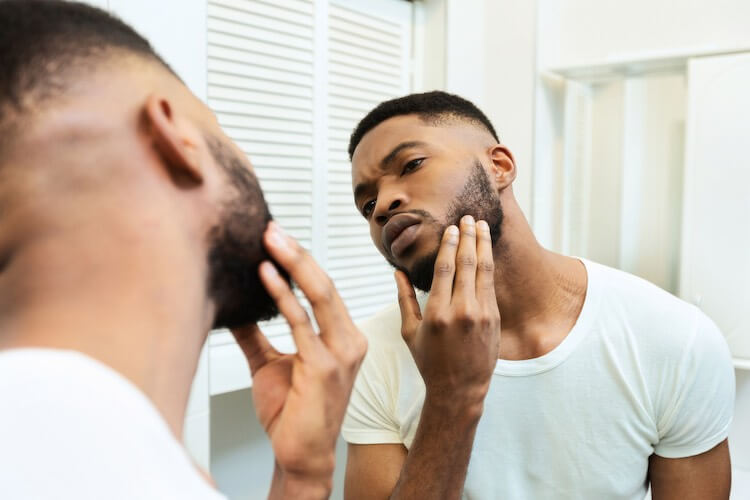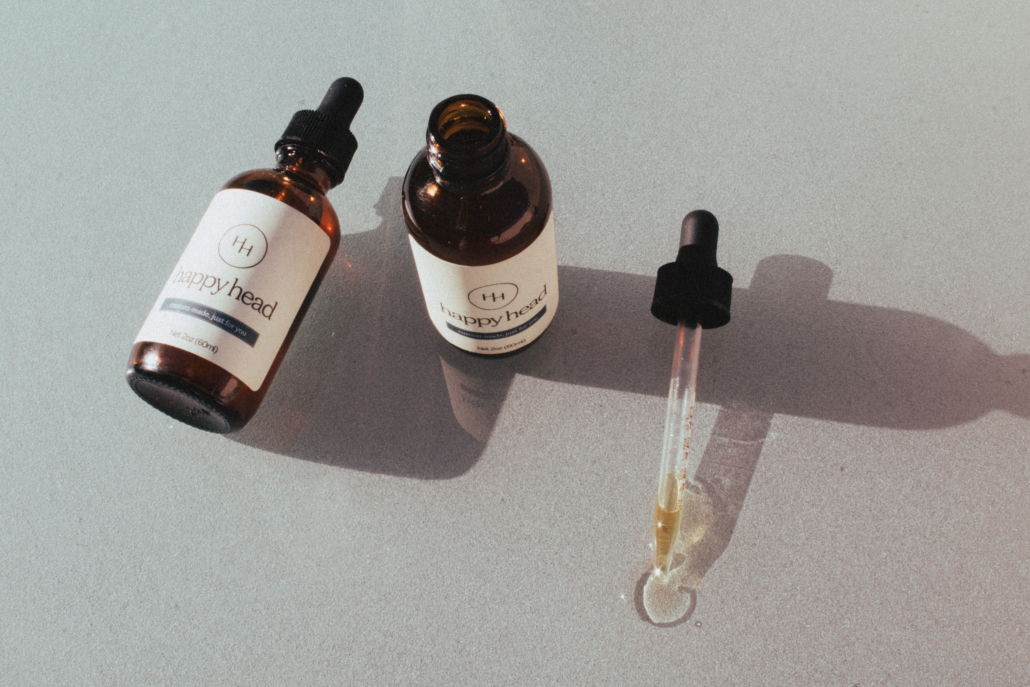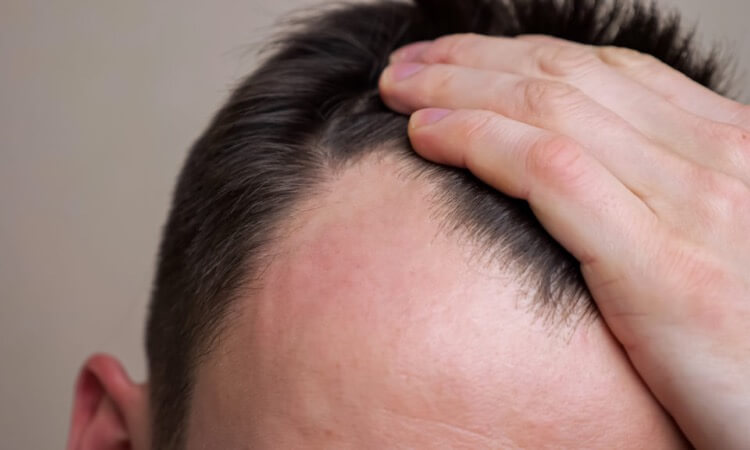Why You Shouldn’t Ignore Beard Hair Loss

Woo hoo! You got an enthusiastic “yes,” and your date is tonight. It’s time to get spiffy. So you pull out your razor, glance in the mirror, and just as you begin to lather up, you notice something strange. A tiny little circle where your beard hair is missing. Is that a bald spot? Was that there yesterday? Will my date notice? Will the hair grow back? Whoa, stop for a minute. Here’s the deal. Beard hair loss can often be treated, but the process takes time and requires a dermatologist’s supervision. Although you shouldn’t panic, you should seek treatment as soon as possible to prevent further beard loss. Here’s what else you should know and why you shouldn’t ignore beard hair loss.
Why is My Beard Hair Falling Out?
Let’s start with the basics. It’s important to understand why your facial hair is falling out. Most of the time, facial hair loss is due to an autoimmune condition called Alopecia Barbae. The condition occurs when your body attacks your hair follicles, causing small, circular patches of hair loss. Alopecia Barbae is usually seen along your jawline, but it can affect any part of your beard. Hair loss can be isolated to one patchy area, or it can be widespread.
If you’ve heard that having one autoimmune disease predisposes you to more, that’s true in this case. The same autoimmune disease that causes Alopecia Areata, which causes patchy round circles of hair loss on your head, causes Alopecia Barbae. People who have Alopecia Areata are more likely to experience Alopecia Barbae. That doesn’t necessarily mean that you will see hair loss on both your head and beard. You can get one without the other. The condition is unpredictable, which can make management extremely frustrating. Having thyroid disease, diabetes, lupus, or psoriasis can also make you more susceptible to beard hair loss.
Did I Miss the Symptoms of Alopecia Barbae?
How is it possible that you had a full beard yesterday and today you’re finding bald spots? Did you miss something? Could you have prevented the beard loss? Unfortunately, there isn’t a way to predict Alopecia Barbae. As a non-scarring form of Alopecia, there isn’t any redness, itching, or inflammation waving a red flag. There isn’t a way to know what’s to come until your bald patches appear.
Will My Beard Grow Back?
Yes, the hair on your beard may grow back. Alopecia Barbae is non-scarring, meaning that your hair follicles aren’t permanently damaged. Hair can regrow, sometimes spontaneously. Other times, treatment is required. To help boost hair growth all around, you can try to incorporate a hair supplement into your hair care routine.
How Do Dermatologists Diagnose Alopecia Barbae?
Diagnosing Alopecia Barbae takes experience and skill. You definitely shouldn’t ignore beard hair loss. The condition’s distinguishing traits require a dermatoscope or biopsy to see. The first are small hairs that look like exclamation marks. They are wider on top than on the bottom near the hair follicle. Your dermatologist will also look carefully around the bald patch for signs of short vellus hairs. Vellus hairs tend to have a grayish-whitish color and a fluffy texture. Your dermatologist may also see small hairs that break off just underneath the skin. The hairs may look like small black, white, or yellow dots.
What Treatment Options are Available?
If your beard doesn’t regrow on its own, your dermatologist can offer treatment options to help jump-start the process. No treatments are FDA approved, however, dermatologists commonly prescribe medications off-label. Treatment typically focuses on simultaneously calming the immune system and stimulating growth, so you may find yourself using multiple medications at the same time. Because everyone’s body chemistry differs, it may take some experimenting to determine the right mix of medications for you.
Topical or Injected Corticosteroids
Corticosteroids are often used as a first-line approach to suppress your body’s immune system. It may take time for your body to calm down, so be prepared for treatments to be spread over a few months.
Topical or Oral Minoxidil
You may be familiar with Minoxidil for regrowing the hair on your head. Minoxidil can also be safely used to stimulate beard growth. The treatment is often combined with corticosteroids and is a fast, easy, and accessible option for many men.
Platelet-rich Plasma
Platelet-rich plasma treatments have been in the spotlight for many different applications ranging from sports treatments to hair loss therapy. During a PRP treatment, platelets are extracted from your blood, concentrated, and reinjected to stimulate growth. While PRP gets mixed results for other applications, research indicates that PRP therapy produces promising results for treating beard loss. (01)
JAK Inhibitors
Exciting breakthroughs have been made in the past few years using JAK inhibitors to stimulate hair growth among people with severe cases of Alopecia Areata. JAK inhibitors are immune-modulating medications that inhibit the enzymes responsible for causing your body to attack itself. Topical treatments or oral pills are prescribed based on a patient’s needs. At Happy Head, we create custom topical hair loss treatments that are made just for you and your particular hair loss needs.
Anthralin
Anthralin, a topical medication prescribed to treat psoriasis is being used off-label to treat Alopecia Barbae. Although not much research has been conducted on the effectiveness of facial hair, findings indicate that the medication shows promise in treating Alopecia Areata. (02)
Diphencyprone
Diphencyprone has been used since the 70s to treat Alopecia Areata. Like Antralin, there’s limited research on the medication’s use for Alopecia Barbae, but it has demonstrated efficacy in treating Alopecia Areata. It is not unusual for dermatologists to prescribe the medication off-label to patients experiencing severe beard hair loss.
What Else Can Cause Beard Hair Loss?
Keep in mind that neither Alopecia Areata nor Alopecia Barbae is common. A very small percentage of the population is affected. Some men are never able to grow a full beard. For them, sparse facial hair is normal. Stress, medications, poor diet, hormonal imbalances, and other factors can cause beard hair loss. So, before you assume the worst, check in with your dermatologist. There may be an easy fix to get your beard back into shape.
What You Can Do About Beard Hair Loss (Besides Panic)
Beard hair loss is aesthetic, and fortunately, it doesn’t affect your overall health. That said, any alopecia can affect your self-esteem and confidence. While you wait for your hair to grow back, temporary fixes to camouflage the bald spots in your beard can make you feel better. While a close shave may not be your ultimate goal, it can bridge the gap until your hair grows back. Depending upon the size of the bald spot(s) you may also be able to use a little hair cover-up powder. Some creative guys have also found success experimenting with a fine point liquid eyeliner pen in a color that matches their hair.
Stressed about patches in your beard? Don’t have a dermatologist? Can’t get an appointment for months? Happy Head has board-certified dermatologists licensed in every state who can advise you on your beard hair loss as well as scalp hair loss. Simply complete a brief questionnaire to learn whether you are a candidate for our topical Minoxidil or other hair loss treatments that can help regrow facial hair. We can even customize a formula just for you. You shouldn’t ignore beard hair loss when you can find a solution that’s easy to add to your daily routine.
Resources:
(01) https://www.ncbi.nlm.nih.gov/pmc/articles/PMC7193229/
(02) https://pubmed.ncbi.nlm.nih.gov/3314718/




